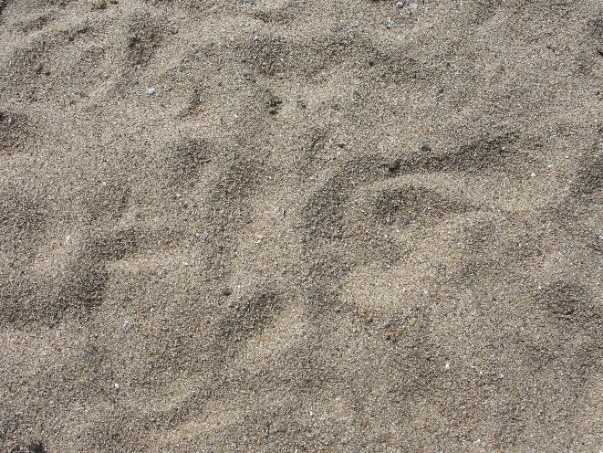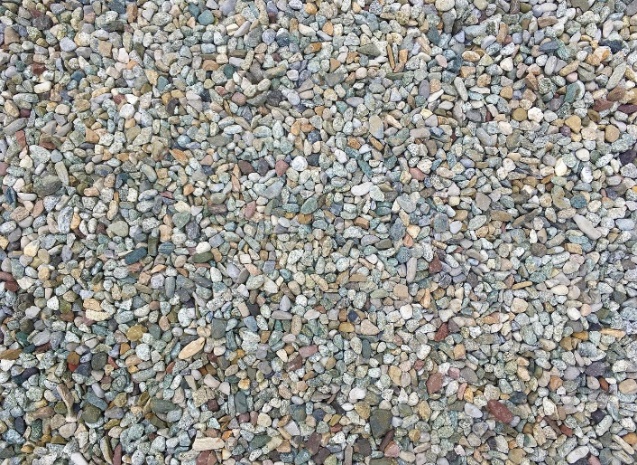8 Chapter Eight: Creating Safe Outdoor Environments
Kelly McKown
Chapter 8 Learning Objectives
By the end of this chapter, you should be able to:
- Illustrate why outdoor play is essential to health and well-being.
- Describe elements of a safe outdoor play space.
- Recognize the importance of impact absorbing surfacing under equipment.
- Explain what use zones are.
- List age appropriate outdoor play equipment for each age group.
- Identify hazards on outdoor play equipment.
- Develop a safety checklist to monitor the safety of the outdoor space.
- Outline ways to protect children from the weather, the sun, insects, drowning, and poisoning.
Introduction
There are countless benefits to outdoor play for children. Research shows that children who play outside regularly have healthier body weight, improved vision, and immune function, reduced stress, better sleep, improved motor skills. There are substantial immediate and long-term health consequences for children who aren’t able to play outside or get enough physical activity such as increased obesity and chronic diseases. The research also shows us that kids who play outdoors have increased school readiness because outdoor play contributes to better social skills such as cooperation, increased attention span, improved school attendance, and improved brain development and cognition. Physical activity plays a critical role in supporting health and learning.
Being aware of the benefits of outdoor learning as they relate to overall health and school readiness is important so that teachers remember that the outdoor environment is an essential extension of the indoor environment. All the learning that takes place indoors can also take place outdoors. Anything programs do indoors can have an outdoor component.
Consider for just a moment how a program can increase the benefits of outdoor play while also minimizing injury. Reducing risk does not mean limiting play equipment or enforcing rules that restrict children’s ability to move and explore their environment. An ideal playground is one that encourages children to challenge themselves while also preventing little risk for injury. In fact, studies show that playgrounds that are high challenge but low risk are the very best at promoting the goals of outdoor learning. Children get more physical activity, develop better physical, cognitive, social skills and are happier and more resilient when their outdoor play environment is challenging and safe.[1]

Outdoor Time for Infants
Many childcare centers take infants outside to ride in a group stroller or buggy. While this is an age-appropriate activity for infants and the babies get the benefit of fresh air, infants need outdoor time where they are free to move about. Infants and young toddlers need to have freedom of movement for much of the day to practice motor skills. There is much for very young children to explore outdoors and they need the opportunity to do so in a safe environment.
Playground Safety
When designing an outdoor space for children, it is critical to reduce the risk of injury while increasing the challenge. The first step is knowing what aspects of the actual learning environment are most likely to cause injuries.
Falls from, into, or on equipment are the most common cause of injury. Falls are most likely to occur on equipment that is not appropriate for the age and development of the children. And injuries are most likely to occur when the surface on which a child falls is not sufficiently shock-absorbing. The equipment pieces that are associated with the most injuries include climbers, such as monkey bars or overhead ladders, swings, and slides. About 85% of all playground injuries occur on these three pieces of equipment. And the most common cause of death on playgrounds is strangulation, that’s an injury that chokes the child.
It’s important to understand that injuries are not accidents. Most injuries are predictable and preventable. Programs can take steps to prevent serious injuries by
- choosing developmentally-appropriate play equipment to ensure children do not fall from a high level and the challenges on the playground are matched with their ability.
- installing proper surfacing to minimize the severity of an injury if a child does fall.
- providing intentional and active supervision by maintaining close proximity to children, especially in places that are high risk for injury from a fall such as the slide or monkey bars).
- encouraging safe behaviors by introducing safety habits to children.
Reinforcing these safe behaviors in an early care and education program provides lifelong lessons about safety and injury prevention. As consultants, you can work with your program and teachers to predict and prevent many injuries and allow children to play.
Designing for Safety
Safe outdoor play space starts with selecting and correctly installing safe and age and developmentally-appropriate structures. The play space design should not be a hazard and should separate active play areas such as swings and slides from quieter activities such as the sandbox, nature-based learning, and dramatic play areas. Only equipment that is manufactured for public playgrounds or child care facilities should be used. So, home playground equipment like Little Tykes brand or plastic sets that home use at local stores are not appropriate.
To assess whether equipment is safe, you should look for these labels. Equipment must meet Consumer Product Safety Commission or CPSC recommendations and the American Society for Testing and Materials, or ASTM, standards. These are two organizations that set standards for design and manufacturing that ensure the equipment is safe. These logos can give you some peace of mind and knowing the equipment has been developed with the highest safety standards. And of course, it also needs to be installed according to the manufacturer’s instructions and properly maintained.
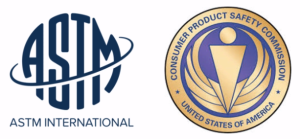
Once playgrounds are installed, they should be inspected at least once each year by an inspector or local regulatory agency and whenever changes are made to the equipment or the intended users change. The inspection will identify hazards, check for proper equipment, installation, and maintenance, and provide a report that identifies and prioritize corrective actions to take to address any concerns. Together with a program, the consultant can review, discuss, and make a plan to address the inspector’s concerns that are immediate right now as well as how to plan to prevent any issues in the future. [3]
Importance of Impact Absorbing Surfaces
The playground surface is the material that lies under and around playground equipment. The surface material under the equipment should be able to cushion a child’s fall. Injuries from falls occur not because children fall, but because the surface on which they fall isn’t able to adequately absorb the impact of their fall. Proper surfacing is prevention of predictable injuries.
There isn’t a single best surface to use on playgrounds. The best surface is the one that:
- the program can afford
- the program is able to appropriately maintain
- meets the needs of the children based on their age
- is workable given the climate where the program is located
- consistently meets the standard for depth that is based on the height of the equipment on the playground.
Surfaces such as asphalt, cement, dirt, and grass, however, are not acceptable surfaces. Grass is not an impact-absorbing surface. If a child falls onto grass, they are far more likely to get hurt than they are if they fall onto an appropriate impact absorbing surface.
There are two types of appropriate, impact-absorbing playground surfaces, unitary and loose-fill. Let’s look at each.
Unitary material such as tiles, mats, or a rubber surface is engineered to be sufficiently shock-absorbing.[4] There are many options. If a program wants to use a unitary surface, it’s important that one is chosen for the appropriate height of equipment and that the manufacturer’s instructions are followed closely (and some require professional installation).[5] Table 4.1 shows some examples of unitary surfacing materials.
Table 8.1 – Examples of Unitary Surfacing Materials
 
|
Loose fill surfaces, such as sand, pea gravel, shredded rubber, or engineered wood fiber and mulch, when installed correctly, will also safely cushion a child’s fall.[8] Table 4.2 shows examples of each of these and Table 4.3 details the depth and protection provided by these materials.
Table 8.2 – Loose-Fill Surfacing Materials
Table 8.3 – Minimum Compressed Loose-Fill Surfacing Depths[13]
| Depth of surfacing | Loose-Fill Material | Protects up to Fall Height |
| 6 inches | Shredded/recycled rubber | 10 feet |
| 9 inches | Sand | 4 feet |
| 9 inches | Pea Gravel | 5 feet |
| 9 inches | Wood mulch | 7 feet |
| 9 inches | Wood chips | 10 feet |
Programs need to consider how data can help inform a decision about which surfacing is best for a particular playground. It’s important to think about who will be using the space and for what.
- Some surfaces like pea gravel are not an appropriate choice for infants and toddlers who might put it in their mouths since it can be a choking hazard.
- Few of the loose fill materials are accessible for wheelchair users without significant accommodation, such as a special wheelchair. Engineered wood fibers provide a little bit better access, but solid or unitary materials are best if you have children on the playground with mobility impairments.
- Will the staff be able to maintain the playground surface? All loose fill surfacing required daily raking to maintain depth.
- Consider how tall the equipment is because sand and pea gravel can’t be used at fall heights that are greater than four to five feet.
- The climate is also an important consideration. Factor in temperature, wind conditions, and precipitation, because they all impact the surface materials you choose.
- o Sand can harden when frozen.
- o Artificial surfaces can get really hot, in fact, hot enough to cause burns when they’re exposed to direct sunlight.
- o Loose fill material, with the exception of rubber mulch, compress about 25 percent over time due to use and weathering.
The protective surfacing has to extend for the full use zone, which is the area under and around equipment where children might fall as a playground surface can’t protect a child who falls onto a hard object such as a tricycle instead of onto the protective surface.[14]
|
Pause to Reflect
|
Use Zones
The use zone is the space that encompasses the activity/piece of equipment and the area around that activity/equipment that will keep children from colliding and provides enough separation between different pieces of equipment and types of play. It is also sometimes referred to as a fall zone. The use zone should be free of movable hazards like trikes and toys, rocks, and groups of children who might cluster and fixed hazards such benches.
Use zones vary depending on the size and the type of equipment. For most stationary equipment on the playground, the use zone should extend six feet in all directions (see Figure 4.3).[15] Equipment that is taller than 30 inches should be at least nine feet from other pieces of equipment. And the use zone for swings should extend from the front and rear of the swings twice the height of the swing (see Figure 4.4). [16]


Age Appropriateness
Age-appropriate equipment provides children with opportunities to safely practice gross motor skills without putting them at risk for unnecessary injury. This takes us back to the notion of creating playgrounds that are high challenge but low risk.
Children are less likely to fall when equipment is only used with the age group for which it is designed. Equipment that is made according to the ASPM or CPSC standards will clearly be marked with the age group for which it is intended. And that’s usually either 6 to 23 months of age, 2 to 5 years of age, and 5 to 12 years of age.
Table 8.4 – Age-Appropriate Equipment[20]
| Age | Age Appropriate Equipment |
| 6 to 23 months
|
· equipment under 32 inches high
· ramps · single-file stepladders · spring rockers · slides · bucket swings |
| Not appropriate for any age
|
· trampolines
· swinging gates · climbing ropes that are not secured at both ends · animal figure swings · multiple occupancy swings · rope swings · trapeze bars |
Hazards on Playgrounds
Gaps in equipment such as the space between the platform and the top of the slide or hooks can entangle clothing or entrap body parts, causing trips, falls, or strangulation. Head entrapment into gaps that are large enough for a child’s body to pass through (bigger than 3.5 inches) but too small for a child’s head to pass through (smaller than 9 inches) can injure a child’s neck or choke a child.
Equipment that spins and moves such as steering wheels or springs on rockers can pinch, cut, or crush fingers or other body parts. So, you want to make sure that any equipment that spins or moves is not accessible for little fingers. Broken parts or improperly installed equipment can cause injuries if the equipment tips over, breaks during use, or has sharp or loose parts that can cut or entrap a child. And railings to prevent falls can break if bolts are loose. See Table 4.5 for examples of dangers to watch for on playgrounds.
Table 8.5 – Playground Hazards[21]
| Playground Hazards [22] | |
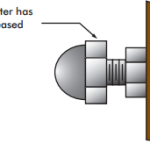 Example of a hazardous projection that increases in diameter from plane of initial surface and forms an entanglement hazard and may also be an impalement hazard. Example of a hazardous projection that increases in diameter from plane of initial surface and forms an entanglement hazard and may also be an impalement hazard.
|
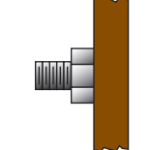
Example of a hazardous projection that extends more than 2 threads beyond the nut and forms an impalement/laceration hazard and may also be an entanglement hazard. |

If the distance between the platform and bottom of the railing is between 3.5 and 9 inches, it is an entrapment hazard. |
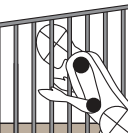 If the distance between an opening (such as this railing) is between 3.5 and 9 inches, it is an entrapment hazard. If the distance between an opening (such as this railing) is between 3.5 and 9 inches, it is an entrapment hazard. |
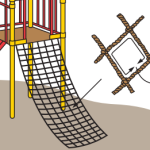
Entrapment hazard: when the perimeter of the net openings is between 17 inches and 28 inches |

Strings on children’s clothing can create entanglement hazards and hood drawstrings can create strangulation hazards. |
Pause to Reflect
Think of that playground again. Did it offer adequate use zones around the different pieces of equipment? Was the equipment used by the appropriate age groups (or did older children play on equipment designed for young children or vice versa)? How well did it protect children from the hazards mentioned (trips and falls, entrapment, impalement, entanglement, or strangulation)?
Riding Toys
All children older than age 1 should wear properly fitted and approved helmets when they are riding toys with wheels or using any wheeled equipment. Helmets should be removed as soon as children stop riding the wheeled toys or using the equipment. Approved helmets should meet the standards of the U.S. Consumer Product Safety Commission (CPSC)[23] and should pass the three-point check for a proper fit as shown in Table 4.6.
Table 8.6 – Three Point Check for Proper Helmet Fit
| Three Point Check for Proper Helmet Fit | |
| 1. Helmet is level on the head, 1 to 2 finger-widths about eyebrows.
2. Straps are even and create a “Y” under each ear with straps laying flat against the head. 3. Chinstrap is buckled loose enough to fit one finger between the buckle and chin, but tight enough the opening the mouth should pull the helmet downward. |
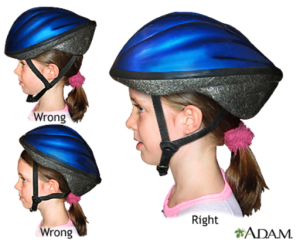 |
“Helmets provide the best protection against head and brain injury, whether [the] child is riding a bike, scooter or skateboard, or using skates. However, a helmet will only protect when it fits well.”[25]
Keeping Children Safe by Monitoring
Early care and education programs need to develop a routine inspection process to identify and prevent hazards. Outdoor play spaces are subject to a lot of wear and tear from use, sometimes misuse, from weather conditions. So, even if a program has correctly installed safe and age and developmentally-appropriate equipment, it still requires regular inspections and maintenance.
The outdoor space, including the playground, should be inspected using checklists such as the ones in Appendix E. It should be inspected upon initial installment.
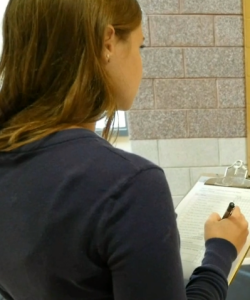
It should also be inspected on a daily basis to identify hazards that may have appeared suddenly. It will also alert staff to any pieces of equipment that may have broken or become worn since last being used. Some general items to include in a daily inspection may include ensuring that
- any broken equipment is removed from children’s access or repaired
- the playground is free from
- o glass, needles, cigarette butts, animal feces, and trash
- o standing water
- o trip hazards
- the use zones are free from obstacles that may have been moved into them, such as tricycles or movable benches
- displaced loose fill surfacing is raked
- platforms and pads are free of sand and surfacing debris and any tripping hazards
- the area is scanned for
- o insects or insect nests
- o broken equipment
- o weather-related hazards such as hot surface or equipment, ice, or other damage from weather
A monthly inspection would include:
- checking for loose or missing hardware, checking
- inspecting equipment for broken parts, splinters, rust, or sharp edges,
- replenishing loose fill surfacing if needed, and
- examining vegetation for hazardous or poisonous plants.
There has to be a system in place to conduct inspections and then respond in a timely manner when something is identified. It’s too common for someone to notice a hazard but to forget to report it or for somebody to report a hazard but then people forget to follow through to correct it. Many checklists include space for writing down a corrective action plan. Once the hazard is identified the person completing the form will write down what steps should be taken to correct the problem, including identifying who will fix it, what needs to be done, and when it will be done. The process should also include a system to check that the problem was fixed in a timely manner.
A record of any injury reported to have occurred on the playground should also trigger an additional inspection of that piece of equipment (this was previously discussed in Chapter 2). This will help identify potential hazards or dangerous design features that should be corrected.
Active Supervision
The most important tool for reducing playground injuries is active supervision (which is also addressed in Chapter 2). Early childhood educator should be actively supervising children at all times. Active supervision is a specific child supervision technique that requires focused attention and intentional observation of children at all times. Active supervision includes six basic strategies.
- Plan and set up the environment to ensure clear sightlines and easy access to the children and the equipment at all times while they’re out on the playground.
- Teachers are positioned among the children in their care, changing positions as needed so that they can keep an eye on the children.
- They are communicating about which children they’re observing and any issues that divert their attention so that they know other teachers are taking up the slack and watching the other children.
- Teachers are watching, counting, and listening to children at all times
- They also use their knowledge of each child’s development and abilities to anticipate what a child might do or to anticipate areas on the playground where a child might need some additional support.
- And if needed, they get involved and they redirect children when necessary or they provide that additional support if needed.[27]
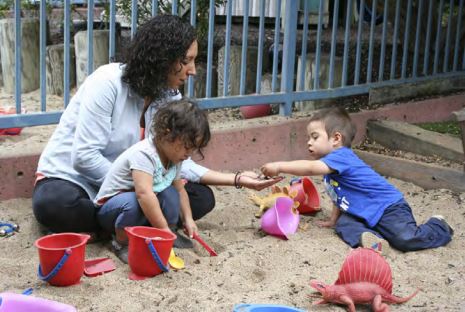
Other Safety Considerations for the Outdoors
In addition to designing and maintaining a safe playground for children, you also need to monitor environmental factors such as weather, the sun, insects, animals, poisonous plants or materials, and water. [28]
Sun Safety
Children need protection from the sun’s harmful ultraviolet (UV) rays whenever they’re outdoors. Shade and sunscreen protect children from sun exposure and can help to reduce the risk of some skin cancers.
According to the Centers for Disease Control and Prevention (CDC), even a few major sunburns can increase the risk of skin cancer later in life. The American Academy of Pediatrics recommends the following guidelines regarding sun safety and the selection and application of sunscreen:
- If possible, use play areas that provide some shade to help children stay cool.
- Protect infants under 6 months from direct sunlight by keeping them in a shady spot under a tree, umbrella, or stroller canopy.
- Limit children’s sun exposure between 10 a.m. and 4 p.m. when UV rays are the strongest.
- Encourage families to dress children in cool clothing such as lightweight cotton pants and long-sleeved shirts. A hat will protect their face, ears, and the back of their neck.
- Obtain written permission from children’s parents/ guardians to use a sunscreen with a SPF (sun protection factor) of at least 15. That is “broad-spectrum” sunscreen to screen out both UVB and UVA rays.
- Apply sunscreen at least 30 minutes before going outdoors so it is absorbed into the skin. It will need to be reapplied every two hours if children are outside for more than an hour, and more frequently if they are playing in water.
- Each child should have their own labeled bottle of sunscreen.
- For children older than 6 months, apply sunscreen to all exposed areas, including children’s ears if they are wearing a cap instead of a hat.
- For children younger than 6 months, use sunscreen on small areas of the body, such as the face and the backs of the hands if protective clothing and shade are not available.

Hydration
Toddlers and preschool children cannot regulate their body temperatures well and need additional water when the weather is hot. Provide regularly scheduled water breaks to encourage all children to drink during active play, even if they don’t feel thirsty. Fluoridated water (bottled or from the faucet) can reduce the risk of early childhood caries, and is the best drink choice for young children in between meals. Each child should be provided their own cup or bottle. Staff may offer additional breast milk or formula to infants as water is not recommended, especially for infants younger than six months of age.[29]
Weather
Teachers should be aware of local weather conditions and monitor the temperature, humidity, and air quality. To stay up to date on current conditions:
- Check the Air Quality Index and limit play outdoors when there is poor air quality.
- Check the forecast for the UV Index to limit exposure to the sun on days when the Index is high.
- Check current and forecasted weather to be aware of the temperature and other weather conditions that may make the outdoors hazardous to children’s health.
The charts in Figure 8.8 are from the Iowa Department of Public Health’s Child Care Weather Watch that will help you protect children from extreme temperatures.
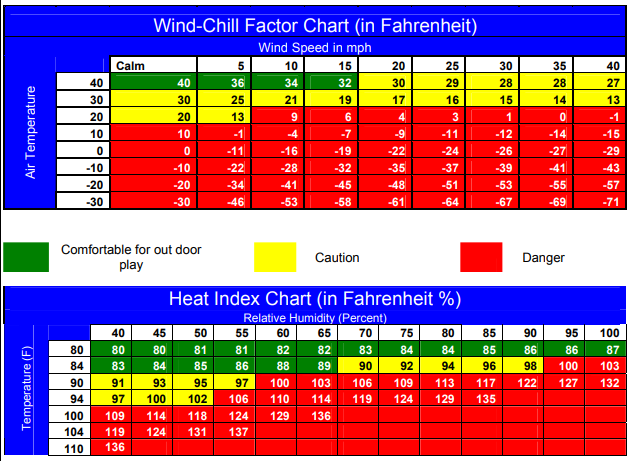
Protecting Children from Heat-Related Illness
Children’s bodies heat up three to five times faster than adults.[31] It’s important to help children during hot weather. Here are some tips from the American Academy of Pediatrics.
- Air conditioning should be provided when temperatures are high.
- Children need to stay hydrated.
- Children sweat less than adults, so they should wear light clothes in no more than one layer.
- Extra downtime to rest and recover from the heat should be provided
- Activities that will help children cool off (such as water play) can be planned.[32]
Protecting Children from Cold Weather
There is no set time that is safe for children to play safely when the weather is cold. Teachers will have to use their best judgment. Use the chart in Figure 4.8 to ensure it is safe to go outside.
When playing outdoors in the cold it is important for children to bundle up. They are at greater risk for frostbite than adults. They should dress in layers. Wet clothing should be removed. Scarves must be tucked into coats to avoid becoming a strangulation hazard. Gloves/mittens and socks must stay dry to protect fingers and toes from frostbite. Children should come in periodically to warm up. And even though it’s cold, sunscreen and hydration are still important.[33]
Protecting Children from Insects
Children and adults can be protected from insect bites by
- Checking for and removing insect nests and spiders under slides, in bushes and in the ground.
- Making sure there is no standing water near play areas for mosquitoes to lay their eggs.
- Checking for ticks after outdoor play. The Center for Disease Control provides instructions about Tick Removal (see Figure 4.10).
- Consulting with the local health department, Health Services Advisory Committee, or a child care health consultant about whether to use insect repellent when local insects are likely to carry diseases.

Water Safety
Drowning is a major cause of death among children under 5 years of age in California. Water safety presents a particular challenge to child care providers. Most drownings in this age group occur in home swimming pools. Water-filled bathtubs, wading pools, toilets, buckets or other containers are also places where top-heavy young children can drown. Water safety presents its own set of challenges to the child care environment.
Children between the ages of 1 and 4 years are at greatest risk from drowning. These children are just learning to walk and explore. They excel at getting out from under the watchful eye of the provider.
Wading in bodies of freshwater may carry the additional risk of injury from cuts, puncture wounds and infections. Standing bodies of water such as swimming pools, wading pools and hot tubs also have the potential for spreading disease, so they are not recommended for use with young children. Instead, the use of sprinklers is recommended.
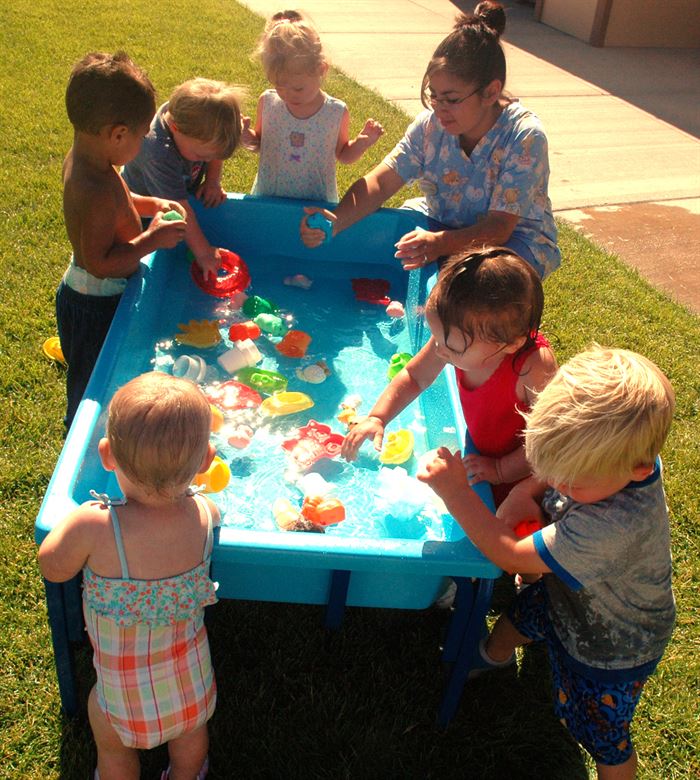
Reducing the Risk of Drowning
Reduce water hazards and prevent access to water
- Safety precautions must be taken to keep any water in the child care environment as risk-free as possible.
- Any body of water poses a threat and young children can drown in as little as one inch of water,
- The indoor and outdoor environments should be thoroughly screened to detect hazards that may lead to the risk of drowning
Promote safe behaviors
- Because children move quickly, are curious and do not understand their physical abilities, they must be watched carefully around even small bodies of water.
- The majority of drownings occur within a surprisingly short period of time.
- Never, ever, leave a child alone, even for a moment, when there is a body of water in the environment.
- When near water, always reinforce safety for the children.
- Plan water play when children are the least tired and most alert.
- Teach children safe practices for swimming and playing in the water.
- Have a telephone within easy reach at all times.
Learn proper response if there is a water emergency and act immediately
- Pull the child from the water and place the child on his/her back.
- Check for breathing, and clear mouth and nose of any obstructions.
- Get another adult to call for emergency help.
- Begin rescue breathing or CPR as needed until the child is revived or help arrives.
Preventing Drownings
- Never leave a child alone in or near any body of water (tub, wading pools, shower, pool, water table or even a bucket).
- Always provide careful, direct and constant supervision of young children if there is a body of water present in the environment.
- Never expect swimming instruction to eliminate the risk of drowning in children.
- Supervise children in the water even if they are wearing flotation devices. These devices are not substitutes for constant supervision.
- Any hazard should be enclosed with a fence that is at least five feet tall and not easy to climb. A door or sliding glass door is not a safe substitute for a fence.
- Gates should have locks that are at least 55 inches high and self-closing. Keep gate keys in a safe place away from children.
- Never leave pool covers partially in place because children can become trapped beneath them. Pool covers are not a substitute for fencing.
- Keep chairs, tables and climbing equipment away from pool fences to prevent children from climbing over the fence into the pool.
- Learn CPR and keep rescue equipment at poolside, including a life preserver, shepherd’s crook and cordless telephone to call 9-1-1.
- If a portable wading pool is used in child care (although it is not recommended), it should be filled with water, used immediately, drained and put away as soon as children leave the pool.
- Never leave infants or children unattended around five-gallon buckets containing even a small amount of liquid. Empty buckets when not in use.
- Children with seizure disorders are particularly vulnerable to drowning. Know your children’s medical history.
- Teach children water safety behaviors:
- o Do not run, push or play around swimming areas.
- o Do not swim with anything in your mouth.
- o Do not swim in very cold water because it increases the risk of drowning.
- o Look out for other children who might be in danger.
- o Do not go near a pool unless supervised.
- o Do not scream for help unless you mean it.
- o Do not roughhouse in the water.[36]
Preventing Poisoning Outdoors
This topic was covered in Chapter 3, but it is important to note that poisonous materials are also found outdoors, including some of the plants in Table 3.8.
Storing Toys, Materials, and Equipment Safely
In order to protect toys, materials, and equipment from the elements, they should be safely stored when not in use. Keep storage areas clean and dry to prevent mold and infestations of insects, spider, rodents, or other pests.
Motor Vehicle Safety
Motor vehicle injuries are a leading cause of death among children in the United States. But many of these deaths can be prevented.
- In the United States, 723 children ages 12 years and younger died as occupants in motor vehicle crashes during 2016, and more than 128,000 were injured in 2016.
- One CDC study found that, in one year, more than 618,000 children ages 0-12 rode in vehicles without the use of a child safety seat or booster seat or a seat belt at least some of the time.
- Of the children ages 12 years and younger who died in a crash in 2016 (for which restraint use was known), 35% were not buckled up.[46]
Safely Transporting Children
Any licensed driver transporting children should be trained in safety practices and if alone, have CPR and first aid training. They should have a safe driving record and their license should authorize them to drive the type of vehicle being driven. [47]

The interior of vehicles used to transport children for field trips and out-of-program activities should be maintained at a temperature comfortable for children. All vehicles should be locked when not in use, headcounts of children should be taken before and after transporting to prevent a child from being left in a vehicle, and children should never be left in a vehicle unattended. [49]
Hot Car Warning!

“Never leave children in a car or in another closed motor vehicle. The temperature inside the car can quickly become much higher than the outside temperature—a car can heat up about 19 degrees in as little as 10 minutes and continue rising to temperatures that cause death.” [50] |
Passenger Safety in Motor Vehicles
When children are driven in a motor vehicle other than a bus, all children should be transported only if they are restrained in a developmentally appropriate car safety seat, booster seat, seat belt, or harness that is suited to the child’s weight and age in accordance with state and federal laws and regulations. The child should be securely fastened, according to the manufacturer’s instructions. The child passenger restraint system should meet the federal motor vehicle safety standards and carry notice of compliance. Child passenger restraint systems should be installed and used in accordance with the manufacturer’s instructions and should be secured in back seats only.
Car safety seats should be replaced if they have been recalled, are past the manufacturer’s “date of use” expiration date, or have been involved in a crash that meets the U.S. Department of Transportation crash severity criteria or the manufacturer’s criteria for replacement of seats after a crash.[51]
Buckling children in age- and size-appropriate car seats, booster seats, and seat belts reduces the risk of serious and fatal injuries:
- Car seat use reduces the risk of injury in a crash by 71-82% for children when compared to seat belt use alone.
- Booster seat use reduces the risk for serious injury by 45% for children aged 4–8 years when compared with seat belt use alone.
- For older children and adults, seat belt use reduces the risk of death and serious injury by approximately half. [52]

Tips for Safe Field Trips
Early care and education programs can be enriched through carefully planned field trips. It is important that the destination be appropriate for the age and developmental level of each child that will be attending. Any special arrangements needed to make sure that all children can safely be included should be made ahead of time.
All staff and background-checked volunteers that will be attending should be made familiar with the travel plans, the field trip location, rules, and their responsibilities. The children should also be prepared for the trip. Teachers can review and practice safety precautions and emergency procedures.
Families should be made aware of the field trip and provide consent for their child to attend. Emergency information for every child should be kept with staff off-site at all times. An accurate list of all children in attendance must be kept as well (at the field trip destination and at the school/center).
Adults should be assigned small groups of children. All adults should be made aware of the chosen regrouping location and checkpoints. Information is also provided in Chapter 6 about preventing lost children on field trips.[54]
Summary
Safe, outdoor play is vital to children’s health and well-being. Environments that are well designed, with age appropriate, hazard-free equipment, impact absorbing surfaces, and use zones around equipment will protect children from many injuries. Supervising children and actively monitoring the outdoor space are also key to preventing injuries. Having knowledge about the weather, implementing sun safety practices, protecting children from insects, following safe practices around water play, and storing toys safely are also important for children’s safety. When going off site (and during drop off and pick up times), it’s important to remember pedestrian safety and how to safely transport children in motor vehicles.
Chapter 8 Review
|
Resources for Further Exploration · Safe Kids Worldwide: https://www.safekids.org/ · National Recreation and Park Association: https://www.nrpa.org/ · National Program for Playground Safety: https://playgroundsafety.org/ · Public Playground Safety Handbook by the Consumer Product Safety Commission: https://www.cpsc.gov/s3fs-public/325.pdf · Child Care Weather Watch: https://idph.iowa.gov/Portals/1/Files/HCCI/weatherwatch.pdf · Sun Safety for Schools: https://www.cdc.gov/cancer/skin/basic_info/sun-safety-tips-schools.htm · Shade Planning for America’s Schools: https://www.cdc.gov/cancer/skin/pdf/shade_planning.pdf · Child Passenger Safety: https://www.cdc.gov/motorvehiclesafety/child_passenger_safety/index.html
|
References
[1] Playgrounds! By the Office of Head Start is in the public domain.
[3] Playgrounds! By the Office of Head Start is in the public domain.
[4] Playgrounds! By the Office of Head Start is in the public domain.
[5] Public Playground Safety Handbook by the U.S. Consumer Product Safety Commission is in the public domain.
[6] Sheung Ning Playground Walking Tiles by Prosperity Horizons is licensed under CC BY-SA 4.0.
[8] Playgrounds! By the Office of Head Start is in the public domain.
[9] Gfp-wood-chips by Yinan Chen is in the public domain.
[10] Spreading Rubber Mulch on Playground by VSPYCC is licensed under CC BY 2.0.
[11] A view of river sand by Thamizhpparithi Maari is licensed under CC BY-SA 3.0.
[12] Gravel Texture Pebble by Selrond is in the public domain.
[13] Public Playground Safety Handbook by the U.S. Consumer Product Safety Commission is in the public domain.
[14] Playgrounds! By the Office of Head Start is in the public domain.
[15] Playgrounds! By the Office of Head Start is in the public domain.
[16] Public Playground Safety Handbook by the U.S. Consumer Product Safety Commission is in the public domain.
[17] Public Playground Safety Handbook by the U.S. Consumer Product Safety Commission is in the public domain.
[18] Public Playground Safety Handbook by the U.S. Consumer Product Safety Commission is in the public domain.
[19] Public Playground Safety Handbook by the U.S. Consumer Product Safety Commission is in the public domain.
[20] Public Playground Safety Handbook by the U.S. Consumer Product Safety Commission is in the public domain.
[21] Public Playground Safety Handbook by the U.S. Consumer Product Safety Commission is in the public domain.
[22] Public Playground Safety Handbook by the U.S. Consumer Product Safety Commission is in the public domain.
[23] Summer Safety Tips for Early Care and Education Programs by the Office of Head Start is in the public domain.
[24] Head injury-first aid by the National Library of Medicine is in the public domain.
[25] Seattle Children’s Hospital. (2018). Bike and Multi-Sport Helments: Quick-fit Check. Retrieved from https://www.seattlechildrens.org/pdf/CE222.pdf
[26] Center for Family Involvement. (2018). Collecting Data Using a Task Analysis. Retrieved from https://vimeo.com/281486327.
[27] Playgrounds! By the Office of Head Start is in the public domain.
[28] Public Playground Safety Handbook by the U.S. Consumer Product Safety Commission is in the public domain.
[29] Summer Safety Tips for Early Care and Education Programs by the Office of Head Start is in the public domain.
[30] Iowa Department Public Health. (2009). Child Care Weather Watch. Retrieved from https://www.c-uphd.org/documents/wellness/weatherwatch.pdf
[31] Safe Kids Worldwide. (2020). Risk Areas We Work In. Retrieved from https://www.safekids.org/preventing-heatstroke
[32] American Academy of Pediatrics. (2020). Protecting Children from Extreme Heat: Information for Parents. Retrieved from https://www.healthychildren.org/English/safety-prevention/at-home/Pages/Protecting-Children-from-Extreme-Heat-Information-for-Parents.aspx
[33] Cold Weather Safety from the Office of Head Start is in the public domain.
[34] Tick Bite: What to Do by the Centers for Disease Control and Prevention is in the public domain
[35] Splish Splashing and Having Fun! By Lorna Gutierrez is in the public domain.
[36] California Childcare Health Program. (n.d.). Prevent Drowning. Retrieved from https://cchp.ucsf.edu/sites/g/files/tkssra181/f/drownen081803_adr.pdf
[37] National Strategies for Advancing Child Pedestrian Safety by Richard A. Scheiber, MD, MPH and Maria E. Vegega, PhD is in the public domain.
[38] We don’t need buses for our class field trips by Woodleywonderworks is licensed under CC BY 2.0
[39] Healthy Families BC. (2016). Pedestrian Safety Tips to Teach Kids. Retrieved from: https://www.healthyfamiliesbc.ca/home/blog/pedestrian-safety-tips-teach-kids
[40] A Kid’s Guide to Safe Walking by the NHTSA is in the public domain.
[41] Lesson 1: Walking Safely Near Traffic by the NHTSA is in the public domain.
[42] A Kid’s Guide to Safe Walking by the NHTSA is in the public domain.
[43] Lesson 1: Walking Safely Near Traffic by the NHTSA is in the public domain.
[44] Healthy Families BC. (2016). Pedestrian Safety Tips to Teach Kids. Retrieved from: https://www.healthyfamiliesbc.ca/home/blog/pedestrian-safety-tips-teach-kids
[45] A Kid’s Guide to Safe Walking by the NHTSA is in the public domain.
[46] Child Passenger Safety: Get the Facts by the CDC is in the public domain
[47] Qualifications for Drivers by the Office of Head Start is in the public domain.
[49] Interior Temperature of Vehicles by the Office of Head Start is in the public domain.
[50] American Academy of Pediatrics. (2020). Protecting Children from Extreme Heat: Information for Parents. Retrieved from https://www.healthychildren.org/English/safety-prevention/at-home/Pages/Protecting-Children-from-Extreme-Heat-Information-for-Parents.aspx
[51] Child Passenger Safety by the Office of Head Start is in the public domain.
[52] Child Passenger Safety: Get the Facts by the CDC is in the public domain
[54] New Jersey Department of Education. (2019). Preschool Guidance and Materials. Retrieved from https://www.nj.gov/education/ece/psguide/trip.htm


